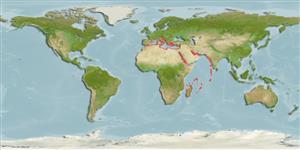Common names from other countries
Classification / Names / Names
Nomi Comuni | Sinonimi | Catalog of Fishes (gen., sp.) | ITIS | CoL | WoRMS
Environment: milieu / climate zone / depth range / distribution range
Ecologia
; salmastro; distribuzione batimetrica 15 - 40 m (Ref. 107883). Subtropical
Western Indian Ocean and the Mediterranean Sea.
Length at first maturity / Size / Peso / Age
Maturity: Lm ? range ? - ? cm
Intertidal lagoon, on mudflats. Favors soft mud and may sometimes climb mangrove pneumatophores or shelter under loose flaps of the black mats of cyanobacteria in the uppermost intertidal zone (Ref. 101158). Detritus feeder (Ref. 115396). Scraper herbivore (Ref. 115397).
Life cycle and mating behavior
Maturità | Riproduzione | Deposizione | Uova | Fecundity | Larve
Members of the order Neotaenioglossa are mostly gonochoric and broadcast spawners. Life cycle: Embryos develop into planktonic trocophore larvae and later into juvenile veligers before becoming fully grown adults.
Templado, J. and R. Villanueva. 2010. (Ref. 85339)
IUCN Red List Status (Ref. 130435)
CITES status (Ref. 108899)
Not Evaluated
Not Evaluated
Threat to humans
Harmless
Human uses
| FishSource |
Strumenti
Informazioni ulteriori
Age/Size
Accrescimento
Length-weight
Length-length
Morfologia
Larve
Abbondanza
Fonti Internet
Estimates based on models
